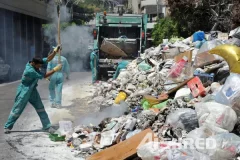
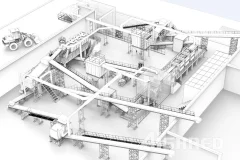
Diversified recycled products and construction waste recycling equipment with high treatment capacity have become important factors to help market development. Here are the detailed steps of construction waste recycling. The first step of construction waste treatment is to pre-screen and separate the muck for backfilling; After pre screening, the raw materials are broken into aggregates of different sizes, usually by two-stage crushing; Then the vibrating screen is used to divide the aggregate screen into different particle sizes for different purposes. Generally, the required particle sizes of sand aggregate are 0-5mm, 5-10mm, 10-31.5mm. These aggregates with different particle sizes have different uses, such as making recycled bricks, road cushion, etc. In the process of crushing and screening, manual sorting and magnetic separation equipment are also required to sort out recyclable and combustible materials for incineration power generation or RDF fuel rods. The equipment used in the whole production line
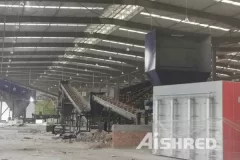
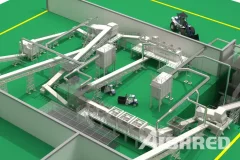
C&D Waste Recycling Plant for Sale in Russia
2023-02-01In Russia, there is a lot of demand for sorting construction and demolition waste for recycling and production of new products. We, AIShred (belonging to GEP Ecotech), have had many cases of construction and demolition waste treatment in Russia, China, Indonesia, Canada and other regions. Unlike other companies engaged in mining machinery (if you buy equipment from China, you may know that many Chinese suppliers used to focus on the aggregate and mining fields), AIShred focuses on providing solid waste recycling equipment, so we are more professional in providing C&D waste recycling plant. As shown in the picture above, this is the rendering of the Stationary C&D waste recycling plant we designed for a customer from Russia, which can handle pure construction waste and mixed construction waste. Final products include recycled aggregates, sand, metals, combustible materials, etc. We provide customers with many different options of construction waste sorting and recycling plants, free design solutions, accept
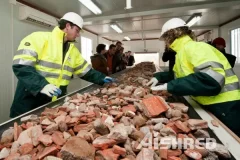
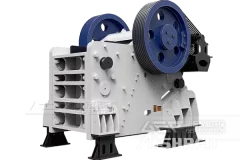
Construction waste disposal can greatly reduce the cost of construction waste stacking, but also help to protect the environment, which is of great significance. AIShred is a national high-tech enterprise focusing on the R & D, production, sales and service of intelligent, environmental protection technologies and solid waste recycling equipment. AIShred has always been committed to the sustainable development of green technology and the recycling of solid waste. At the end of June of 2022, our company came to an order with an Russian customers for our GEC series jaw crusher equipment for the treatment of 100t/h construction waste. At present, we are preparing for the goods. Overview of Construction Waste Disposal EquipmentOur construction waste disposal equipment mainly includes GEY series hydraulic cone crusher, GEC series jaw crusher, GEF series impact crusher, GEV series sand making machine and relevant auxiliaries. The GEC series jaw crusher purchased by the customer is a special treatment equipment for
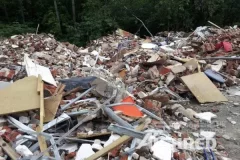
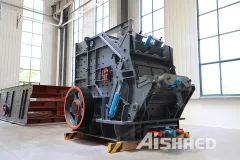
Construction waste recycling plant for sale in Southeast Asia, the recycling plant can be customized according to the needs of customers, and can be designed in different capacity, adopted for different materials contains. After sorting, removing or crushing, many wastes in construction waste can be reused as regeneration, mainly including:The coarse and fine aggregates produced from waste building concrete and waste bricks can be used to produce concrete and mortar of corresponding strength grade or to prepare building materials products such as blocks, wall panels, floor tiles, etc. The coarse and fine aggregates can also be used for the base course of highway pavement after adding solidified materials.The waste bricks and tiles can be used to produce recycled bricks, blocks, wall panels, floor tiles and other building materials.The muck can be used for road construction, pile foundation filling, foundation, etc.For the waste wood construction waste, the wood that has not been obviously damaged can be
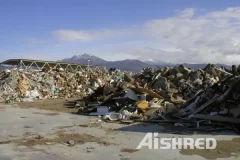
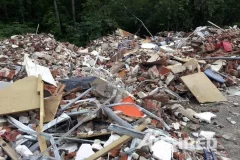
Construction and Demolition Waste Recycling
2022-06-02Construction and demolition (C&D) waste generally constitutes about 10%–20% of total urban solid waste, it includes bricks, tiles, stone, soil, rubble, plaster, drywall or gypsum board, wood, plumbing fixtures, non-hazardous insulating material, plastics, wall paper, glass, metal (e.g., steel, aluminium), asphalt, etc. C&D and other inert waste may be utilised for making bricks, pavement blocks, construction materials such as aggregates etc.The use of C&D waste will minimise the cost of managing such waste and requirement for valuable landfill space, and also save natural resources and reduce the use of virgin soil. Benefits of Processing C&D WasteC&D waste can be put to a profitable use, given the scarcity of sand and stone for construction, thereby saving natural resources.It prevents public nuisance and traffic congestion issues arising from indiscriminate dumping of C&D waste.It saves valuable space at landfill sites.It reduces cost of bulk transportation if recycled close to source of generation.C&D
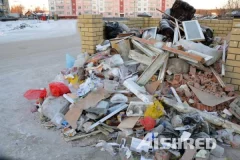
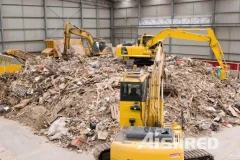
Construction Debris Grinders for Sale
2022-05-11Construction waste is generated from the various construction activities of building, maintaining, renovating, and demolishing infrastructure facilities. This is not only concrete, bricks, pieces of metal, but also dismantled doors and windows, removed linoleum, old wallpaper and so on. A common name for construction debris is construction and demolition waste(C&D waste). Construction debris must be disposed of for a fee by specialized organizations that have the appropriate license. So, many waste management companies and other investor interested in entering this field.How to Recycling Construction DebrisThere are many valuable substances in Construction Debris, metals and large wood can be recycled, small wood and plastic waste can be made into alternative fuels, concrete and bricks can be made into recycled aggregates and building fillers. After being processed by a Construction Waste Treatment Facility, only a very small portion of materials goes to landfills. Equipment for Processing Construction Debris
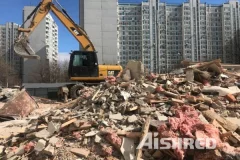
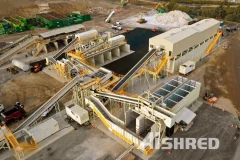
Recycling of Construction Waste
2022-04-20In the process of repair and construction, a large amount of waste is generated at the facilities. Construction waste can be divided according to dimensions: large, medium and small. The first group includes stones, reinforced concrete structures. To medium - fragments of bricks, pieces of wood or finishing materials, and to small construction waste - sand or concrete chips. Theoretically, all construction waste can be used, but subject to separation. To do this, some companies provide large containers for the accumulation of construction waste separately by type: metal, plastic, glass, stones (brick, hardened mortar and concrete), wood. Such an organization of construction waste collection is beneficial for builders, since in this case the tariff for waste removal is lower. Companies involved in the disposal of construction waste get rid of the need to sort such waste.Construction Waste Recycling Equipment Untimely disposal of construction waste would lead to catastrophic environmental pollution, negative



